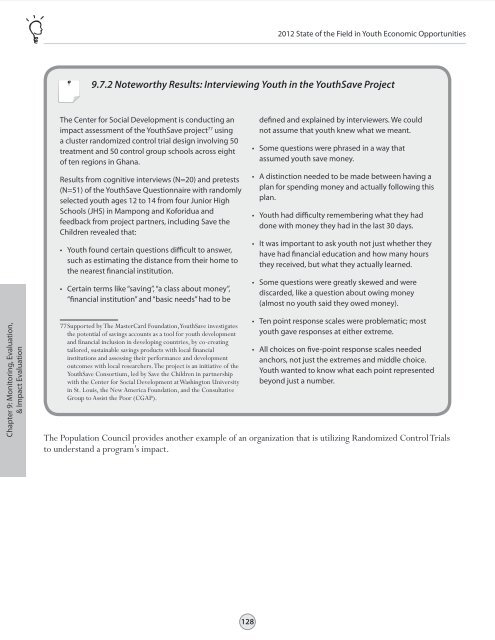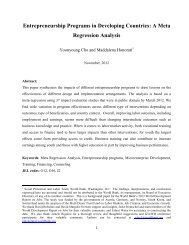STATE OF THE FIELD IN YOUTH ECONOMIC OPPORTUNITIES
STATE OF THE FIELD IN YOUTH ECONOMIC OPPORTUNITIES
STATE OF THE FIELD IN YOUTH ECONOMIC OPPORTUNITIES
Create successful ePaper yourself
Turn your PDF publications into a flip-book with our unique Google optimized e-Paper software.
Table of Contents<br />
Chapter 1 Chapter 2 Chapter 3 Chapter 4 Chapter 5 Chapter 6 Chapter 7 Chapter 8<br />
Chapter 9<br />
Chapter 10 Chapter 11 Chapter 12 Chapter 13 Chapter 14 Chapter 15 Annexes<br />
2012 State of the Field in Youth Economic Opportunities<br />
9.7.2 Noteworthy Results: Interviewing Youth in the YouthSave Project<br />
The Center for Social Development is conducting an<br />
impact assessment of the YouthSave project 77 using<br />
a cluster randomized control trial design involving 50<br />
treatment and 50 control group schools across eight<br />
of ten regions in Ghana.<br />
Results from cognitive interviews (N=20) and pretests<br />
(N=51) of the YouthSave Questionnaire with randomly<br />
selected youth ages 12 to 14 from four Junior High<br />
Schools (JHS) in Mampong and Koforidua and<br />
feedback from project partners, including Save the<br />
Children revealed that:<br />
• Youth found certain questions difficult to answer,<br />
such as estimating the distance from their home to<br />
the nearest financial institution.<br />
• Certain terms like “saving”, “a class about money”,<br />
“financial institution” and “basic needs” had to be<br />
defined and explained by interviewers. We could<br />
not assume that youth knew what we meant.<br />
• Some questions were phrased in a way that<br />
assumed youth save money.<br />
• A distinction needed to be made between having a<br />
plan for spending money and actually following this<br />
plan.<br />
• Youth had difficulty remembering what they had<br />
done with money they had in the last 30 days.<br />
• It was important to ask youth not just whether they<br />
have had financial education and how many hours<br />
they received, but what they actually learned.<br />
• Some questions were greatly skewed and were<br />
discarded, like a question about owing money<br />
(almost no youth said they owed money).<br />
Chapter 9: Monitoring, Evaluation,<br />
& Impact Evaluation<br />
77 Supported by The MasterCard Foundation, YouthSave investigates<br />
the potential of savings accounts as a tool for youth development<br />
and financial inclusion in developing countries, by co-creating<br />
tailored, sustainable savings products with local financial<br />
institutions and assessing their performance and development<br />
outcomes with local researchers. The project is an initiative of the<br />
YouthSave Consortium, led by Save the Children in partnership<br />
with the Center for Social Development at Washington University<br />
in St. Louis, the New America Foundation, and the Consultative<br />
Group to Assist the Poor (CGAP).<br />
• Ten point response scales were problematic; most<br />
youth gave responses at either extreme.<br />
• All choices on five-point response scales needed<br />
anchors, not just the extremes and middle choice.<br />
Youth wanted to know what each point represented<br />
beyond just a number.<br />
The Population Council provides another example of an organization that is utilizing Randomized Control Trials<br />
to understand a program’s impact.<br />
128

















